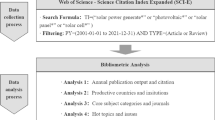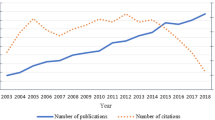Abstract
The science of polymer solar cells and the technology based on it is now pursued as a very exciting and promising area of research at leading universities, national laboratories, and companies throughout the world. In this paper, we conduct a comprehensive and in-depth bibliometric analysis of this area that breaks down scholarly performance into three components—quantity, quality and consistency. The citation data is retrieved from the Web of Science. We identify the most productive organisations, countries, authors and also the most influential journals in which this newly emerging area is published using these criteria.




Similar content being viewed by others
References
Bornmann, L., Mutz, R., Hug, S. E., & Daniel, H. D. (2011). A meta-analysis of studies reporting correlations between the h index and 37 different h index variants. Journal of Informetrics, 5(3), 346–359.
Egghe, L. (2006a). How to improve the h-index. The Scientist, 20(3), 14.
Egghe, L. (2006b). An improvement of the h-index: The g-index. ISSI Newsletter, 2(1), 8–9.
Egghe, L. (2006c). Theory and practice of the g-index. Scientometrics, 69(1), 131–152.
Egghe, L. (2010). The Hirsch index and related impact measures. Annual Review of Information Science and Technology, 44(1), 65–114.
Garfield, E. (1955). Citation indexes to science: A new dimension in documentation through association of ideas. Science, 122(3159), 108–111.
Garfield, E. (1999). Journal impact factor: A brief review. Canadian Medical Association Journal, 161(8), 979–980.
Garfield, E. (2005). The agony and the ecstasy: The history and meaning of the journal impact factor. In International congress on peer review and biomedical publication. http://garfield.library.upenn.edu/papers/jifchicago2005.pdf.
Glänzel, W. (2013). High-end performance or outlier? Evaluating the tail of scientometric distribution. Scientometrics, 97(1), 13–23.
Hirsch, J. E. (2005). An index to quantify an individual’s scientific research output. Proceedings of the National Academy of Sciences of the United States of America, 102(46), 16569–16572.
Katz, J. S. (2005). Scale-independent bibliometric indicators. Measurement, 3(1), 24–28.
Laney, D. (2011). 3D data management: Controlling data volume, velocity and variety. http://blogs.gartner.com/doug-laney/files/2012/01/ad949-3D-Data-Management-Controlling-Data-Volume-Velocity-and-Variety.pdf.
Leydesdorff, L., & Bornmann, L. (2011). Integrated impact indicators (I3) compared with impact factors (IFs): An alternative design with policy implications. Journal of the American Society for Information Science and Technology (in press).
Pendlebury, D. A., & Adams, J. (2012). Comments on a critique of the Thomson Reuters journal impact factor. Scientometrics, 92(2), 395–401.
Prathap, G. (2011a). The energy–exergy–entropy (or EEE) sequences in bibliometric assessment. Scientometrics, 87, 515–524.
Prathap, G. (2011b). Quasity, when quantity has a quality all of its own—toward a theory of performance. Scientometrics, 88, 555–562.
Prathap, G. (2013a). Quantity, quality, and consistency as bibliometric indicators. Journal of the American Society for Information Science and Technology,. doi:10.1002/asi.23008.
Prathap, G. (2013b). The zynergy-index and the formula for the h-index. Journal of the American Society for Information Science and Technology,. doi:10.1002/asi.23046.
Acknowledgments
The comments of an anonymous referee have been extremely helpful in improving the presentation in this paper and this is gratefully acknowledged.
Author information
Authors and Affiliations
Corresponding author
Rights and permissions
About this article
Cite this article
Prathap, G. A three-dimensional bibliometric evaluation of research in polymer solar cells. Scientometrics 101, 889–898 (2014). https://doi.org/10.1007/s11192-014-1346-z
Received:
Published:
Issue Date:
DOI: https://doi.org/10.1007/s11192-014-1346-z




